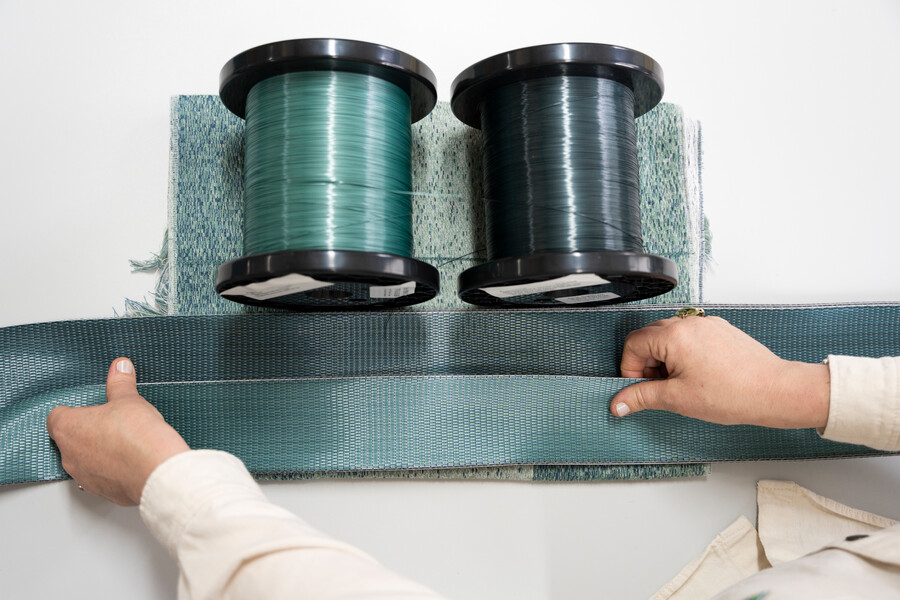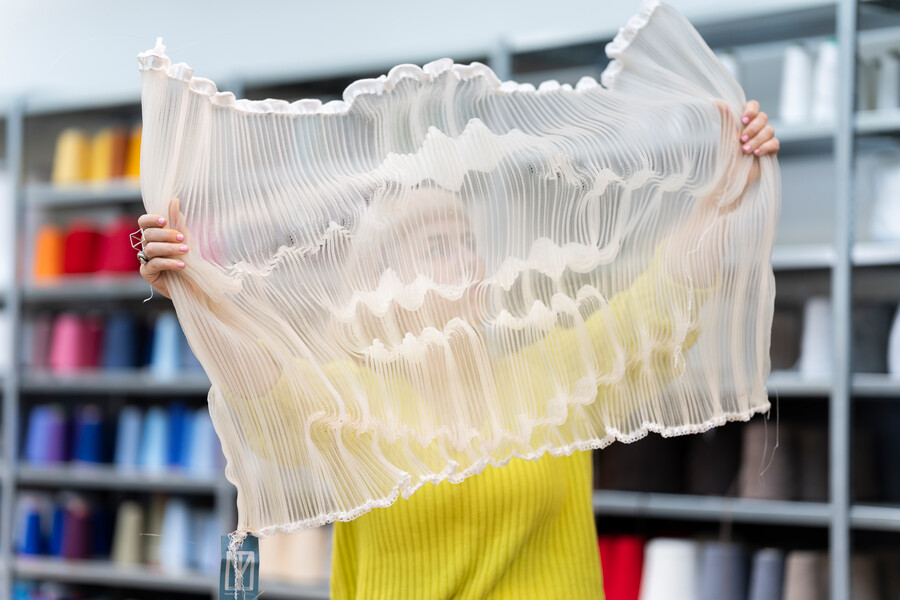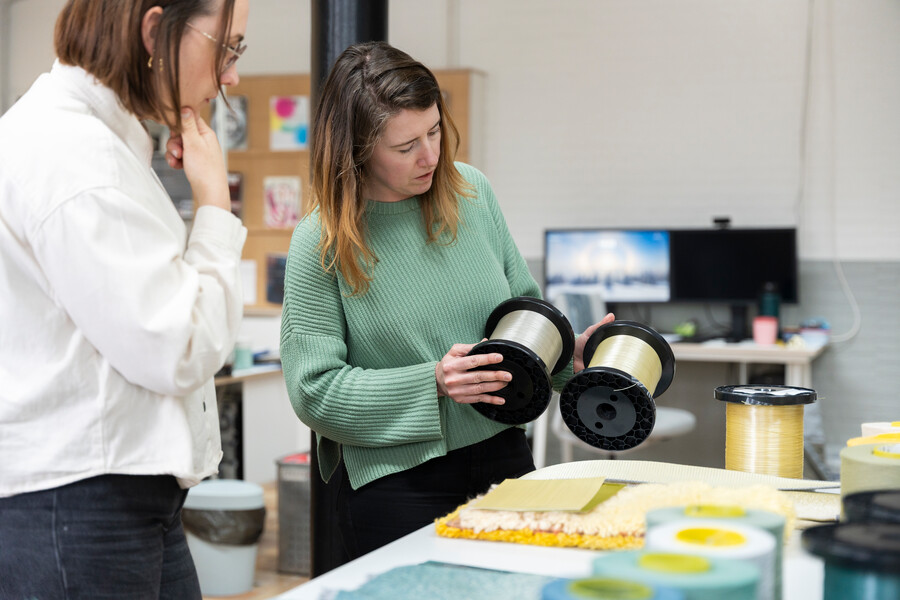
Yarns for eternity | TextielLab goes sustainable
25 September 2025
The textile industry needs to become more sustainable, and TextielLab is keen to find out how. This article marks the start of a new series on how we are working with manufacturers and suppliers to achieve sustainability. It will offer insights into unique biomaterials, planet-friendly designs, complex certifications and recycled PET bottles. We begin with materials consultant Lise Brunt, who not only dreams of sustainable yarns, but also brings them into her home.
Who wouldn't want to buy, produce and sell sustainably? Climate deniers aside, most of us recognise that we need to be more sustainable and environmentally friendly if we want to leave a healthy planet for future generations. Yet 'sustainability' remains a difficult concept to define. The term is not protected and is all too readily used by the commercial sector. What is the situation in the niche of the textile industry in which TextielLab operates? What does the lab actually mean by sustainability and how does the lab team work to make production more sustainable?
What is sustainable?
It is a frequent topic of discussion in the workplace: when does an installation, tapestry, garment or work of art deserve to be labelled sustainable? This spring, they all sat down together for a brainstorming session led by the Envisions design collective.The reason for this was the development of a special product label for the by TextielMuseum-collection, that provides insight into which materials are used in all new products and where they come from. The conclusion of the meeting was that the question of whether a product is sustainable cannot be answered with a simple yes or no. The degree of sustainability depends on many different factors, such as the raw materials used, the 'cleanliness' of the production process, the working conditions during the manufacturing process, the distance the material travels from source to end product, but also its shelf life and recyclability – although the latter is not the most important factor: "It is usually not the intention to recycle the artworks made here; we make them for eternity, so to speak," says materials consultant Lise Brunt.
Local procurement
As the person responsible for purchasing and stocking yarns for the TextielLab, Brunt plays an important role in making the process leading up to the final product or artwork more sustainable. She is constantly on the lookout for more sustainable yarns, scouring trade fairs to keep track of relevant innovations in the field of sustainability and bring them in-house. From unprocessed hemp and animal-friendly mohair to regenerative bioplastics made from grain and sugar waste. An important goal in purchasing is to establish relationships with companies that have sustainable ambitions and are not located too far away. "I think it's important to buy locally as much as possible, to build loyalty among our suppliers and to keep track of who we're dealing with," says Brunt. "On a deeper level, sustainability is also about human contact. You can get all sorts of things cheaply online, perhaps even with the right paperwork. But in the wild west of materials procurement, it's still quite difficult to get a grip on how sustainable things really are in practice. I want to work with people who are willing to explain it to me personally. Ideally, I'd also like to see it with my own eyes in the factory."
PET bottles from the Benelux
The closer, the better, also because the distance the yarns have to travel to the laboratory is then limited – another factor that plays a role in the footprint. Brunt is delighted with the new collaboration with Luxilon Industries in Antwerp, a company she came across at last year's Techtextil trade fair. This Belgian manufacturer, which produces recycled tennis strings for Roland Garros, among other things, subsequently developed a monofilament for the lab that can rightly be called sustainable. Whereas the Global Recycled Standard stipulates that something can be called recycled if it is made from at least 50 per cent reused material, this monofilament is made from 100 per cent recycled PET bottles from the Benelux. It was initially developed specifically for the R&D knitting programme, with both Henrik Vibskov and Marlou Breuls using it on circular and flat knitting machines. The fact that this thread looks slightly cloudier and has more colour nuances than non-recycled monofilament did not bother them: the recycled aesthetic was embraced and the desire to work sustainably remained intact.

Marlou Breuls with a sample for The Room Divider, knitted with recycled polyester monofilament from Luxilon Industries. Photo: Patty van den Elshout on behalf of TextielMuseum.
From experiment to stock
The work of Vibskov and Breuls inspired Mae Engelgeer to also use this monofilament on the weaving machine for the wall covering she developed for Tivoli. At request, black, grey, green and beige variants were also developed for this purpose. As a result, designers and product developers are now asking for more. Brunt wants to have the yarn in stock in ten colours next year: "That completes the circle. What we initiated in an R&D project for an experiment on knitting machines has been taken up by other makers and within other techniques, and thus further developed." It is a fine example of the role that the TextielLab wants to play in accelerating the sustainability of the textile industry, which is still struggling with its enormous ecological footprint.

Lise Brunt and Judith Peskens with the FR recycled polyester monofilament for the woven wall covering at Tivoli Vredenburg. Photo: Patty van den Elshout.
Light-hearted activism
In this way, she is trying to obtain a more sustainable version of everything currently in stock in the lab. "I keep raising the bar," says Brunt, who is already thinking about the next level of recycled monofilament – made from bio-waste. In her enthusiasm, she sometimes forgets to emphasise that many sustainable yarns have been added recently. In addition to recycled polyesters from Belgium and Germany, she mentions Ecovero viscose from Lenzing, unmanipulated natural and black hemp from Ecological Textiles, recycled Lurex and GOTS-certified unbleached cotton, which is now used as warp for all woven TextielMuseum products. Still, as far as she is concerned, things could move a little faster. She wants the lab to be at the forefront and act as a catalyst for the use of many more people- and environment-friendly alternatives. Brunt: "I think we have to make sure that there is something left for those who come after us. It's not up to us to take everything, even if it's still there." During the intake interview with all the makers in the lab, she always asks what role sustainability plays in the project and, where possible, offers more sustainable variants of the desired yarns. "In that sense, we are light-hearted activists here: we don't dictate what the makers should work with, but we can give them ideas."
